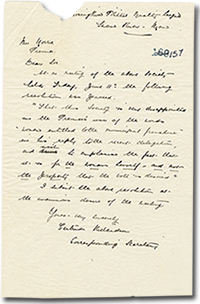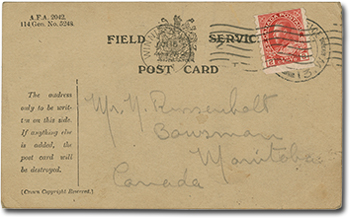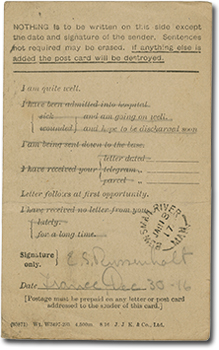The 100th anniversary of the First World War is now finished but the records will continue to be preserved at the Archives and accessible to current and future generations who want to know more about the time period. In addition, this blog will remain on our website as an additional resource.
June 2015 Posts:
- 29 June: Partial Index of Manitoba Soldiers Killed in the First World War
- 22 June: Counting Down to the 100th Anniversary of Womenís Suffrage: The Members of the Roaring River Political Equality League Inform the New Premier of their Disappointment
- 15 June: The Beginnings of the S.S. Nascopie
- 8 June: “Whiz bangs”: Field Service Post Cards
- 1 June: The 6th Battalion “Fort Garry Horse”
29 June 2015
Partial Index of Manitoba Soldiers Killed in the First World War
The Archives of Manitoba has created an electronic index of Manitoba soldiers killed in the First World War. This index was generated from a series of index cards created by the Government of Manitoba for the purpose of documenting Manitoba casualties of the First World War. The original index was made during and after the war but was not a complete record. As a result, this electronic index is also not a complete list of Manitobans killed in the First World War.
The original index is a set of 1092 index cards, with each card containing information on an individual soldier. The cards are handwritten and include name, rank, battalion, date of death, and may also include additional personal information such as community of residence and next of kin. Some have an obituary glued to them. The Archives does not have complete information about the creation or history of these cards. They were found in a sub-basement of the Manitoba Legislative Building and appear to have been assembled by the Department of Public Works for the purpose of creating an honour roll. Likely at least some of the information was submitted by family members.
This electronic index includes fields for the standard information that was collected on the cards. Like the original index, the electronic index is organized alphabetically by surname. The index is fully keyword searchable. When no information was collected on the card for a particular field, the field was left blank in the electronic index. When a card includes an obituary, this is indicated in the “Notes” column.
Four examples of index cards are shown in the November 10th blog post.
Search Tip: Search Keystone to find out more about these records (A 0156, Index cards identifying soldiers killed in World War I, GR8115). Visit the Archives to see the original records.
Feedback (0)
E-mail us at [email protected] with a comment about this blog post. Your comments may be included on this page.
22 June 2015
Counting Down to the 100th Anniversary of Womenís Suffrage: The Members of the Roaring River Political Equality League Inform the New Premier of their Disappointment
After one month in office, Premier T. C. Norris received a letter from Gertrude Richardson, corresponding secretary of the Roaring River Political Equality League. At their 11 June 1915 meeting, the members of the Roaring River branch of the Political Equality League unanimously passed a resolution to inform the new Premier of their disappointment over a recent statement he made concerning the vote for women. Gertrude Richardson’s handwriting is sometimes difficult to read so here is a transcript of the resolution:
“That this Society is very disappointed in the Premier’s use of the words ‘women entitled to the municipal franchise’ in his reply to the recent delegation, and wish to emphasize the fact that it is for the woman herself, and not the property that the vote is desired.”

Archives of Manitoba, Premierís office files, EC 0016, GR1665, 157 . Roaring River Political Equality League's resolution re Premier's attitude to female suffrage, June 1915, G 528.
Richardson was a leading figure in the women’s suffrage movement. The Roaring River branch of the Political Equality League had been founded several years earlier as the Roaring River Suffrage Association, one of the earliest suffrage associations in Manitoba.
The Premier’s response to the letter was quick. On 16 June 1915 he wrote to Gertrude Richardson and the League members, asking them for “a little patience” and assuring them that the government had “no idea of disappointing” them. Just over 7 months later, in January 1916, Manitoba women became the first in Canada to win the vote.

Archives of Manitoba, Premierís office files, EC 0016, GR1665, 158 . Roaring River Political Equality League's resolution re Premier's attitude to female suffrage, 16 June 1915, G 528.
See previous posts about “Counting Down to the 100th Anniversary of Women’s Suffrage” from 26 January 2015, 23 February 2015, and 19 May 2015.
Search Tip: Search “Roaring River Political Equality League” in Keystone for more information.
Feedback (0)
E-mail us at [email protected] with a comment about this blog post. Your comments may be included on this page.
15 June 2015
The Beginnings of the S.S. Nascopie
The Hudson’s Bay Company’s ship, the S.S. Nascopie, spent most of its life as an Arctic ice-breaker, both before and after it was put into wartime service. In the early twentieth century, as the HBC’s trade business in the remote Eastern Arctic increased, there emerged a need for improved transportation into the area. In 1911, the company announced plans for the construction of a new steamship for Arctic service fitted with an ice-breaker bow. That year, the HBC formed the Nascopie Steamship Co. Ltd. together with Job Brothers and Co. Ltd., who were part owners of the ship. In 1916, the HBC purchased Job Brother’s shares in the Nascopie Steamship Co. Ltd. and acquired sole ownership.
On December 7, 1911, the S.S. Nascopie was launched. It had been designed by G.S. Goodwin & Co. of Liverpool and built by Swan Hunter & Wigham Richardson, Neptune Works in Wallsend-on-Tyne, England. The Nascopie was built with a larger cargo capacity than the HBC’s other Arctic vessels; the Nascopie was built to carry 3100 tons, as opposed to the Pelican, whose capacity was 290 tons. Moreover, the Nascopie was designed not only as an ice-breaker, but also for ocean travel since the Newfoundland seal fishery export business required transport to New York and England. For that reason, the Nascopie was perfectly suited for wartime service, to make transatlantic voyages into the icy waters of the White Sea.
Here is G.S. Goodwin & Co.’s general arrangement plan of the Nascopie, dated 25 April 1911 (HBCA A.12/FT 332/1a fo. 26). It was originally enclosed with "Articles of Association: Of The Nascopie Steamship Company Limited", which was sent in a letter from Thomas Cooper & Co. to F.C. Ingrams, Secretary, 2 January 1912, found in Correspondence with Fur Trade Commissioners – SS Nascopie - plan charter parties, articles of association, correspondence between Job Bros. and HBC (A.12/FT 332/1a).

Hudson’s Bay Company Archives, Archives of Manitoba, Correspondence with Fur Trade Commissioners – SS Nascopie – plan charter parties, articles of association, correspondence between Job Bros. and HBC, G.S. Goodwin & Co.’s general arrangement plan of the Nascopie, 25 April 1911, A.12/FT 332/1a folio 26).
See previous posts about the Nascopie from 25 August 2014, 12 January 2015, 9 February 2015, and 2 March 2015.
Search Tip: Use keyword “Nascopie” to search Keystone for more records related to this ship.
Feedback (0)
E-mail us at [email protected] with a comment about this blog post. Your comments may be included on this page.
8 June 2015
“Whiz bangs”: Field Service Post Cards
In the chaos of the trenches, letters were soldiers’ main connection with home. They enabled soldiers to keep in touch with loved ones and conveyed as much news as the military censor would allow. It was not always easy for soldiers to find time to write letters so Field Service Post Cards enabled them to easily convey news to people back home and to confirm that they were still alive and well. Soldiers were prohibited from adding additional information to the card probably as a means of facilitating the work of the military censor. Field Service Post Cards were known as “whiz bangs”, perhaps because they were a quick and simple means of communication; the term “whiz bang” also referred to a type of light calibre German artillery shell.
An excerpt from a letter written by Edgar Russenholt to his sister in November 1916 illustrates the importance of letters to the folks back home, and the use of field service postcards as a simple way of keeping in touch:
“About the mail – Am not sure what the matter is – guess part of it is our own fault – but all the letters the boys have been getting of late, complain of our letters & cards getting home few and far between. Have not written a letter as often as I might – but have sent a ‘whiz bang’ every time we came out to let you know I was O. K. Yes, Am still ‘on top’ and so am mighty thankful.”
Archives of Manitoba, Edgar S. Russenholt fonds, Edgar S. Russenholt Correspondence 1916, P2828/4
Here are the front and back images of one “whiz bang” postcard sent by Edgar Russenholt to Mr. N. Russenholt in Bowsman, Manitoba in December 1916.
Archives of Manitoba, Edgar S. Russenholt fonds, Field Service Post Card addressed to Mr. N. Russenholt, P2828/4.
Visit the Archives of Manitoba to see our display of soldiers’ letters or to see other records related to the First World War. We are located at 200 Vaughan Street in Winnipeg, and we are open Monday to Friday from 9 a.m. to 4 p.m.
Search Tip: The Archives of Manitoba has many collections of letters, including “whiz bang” postcards, from First World War soldiers. Search Keystone for the “Edgar S. Russenholt fonds” or use keywords like “First World War” and “correspondence” to expand your search.
Feedback (0)
E-mail us at [email protected] with a comment about this blog post. Your comments may be included on this page.
1 June 2015
The 6th Battalion “Fort Garry Horse”
This panoramic photograph depicts the 6th Battalion, 2nd Brigade of Canada’s Expeditionary Force posing in uniform at the Valcartier training camp in Quebec. The photograph shows the brigade’s commanding officers kneeling in the foreground with their men behind them. Several mounted soldiers and supply wagons appear in the background in front of rows of military tents and outbuildings.
The 2nd Brigade’s 6th Battalion, known as the “Fort Garry Horse,” was mobilized for combat on August 5, 1914. The battalion was composed primarily of Manitoban soldiers and served as part of the Canadian Expeditionary Force’s cavalry regiment for most of the First World War. The battalion was involved in a number of important battles including Cambrai and Moreuil Wood.
The photograph contains the mark of Winnipeg’s Rembrandt Studio and was taken in Quebec.

Archives of Manitoba, "6th Battalion ‘Fort Garry's’ 2nd Brigade Expeditionary Force 1914. Valcartier Quebec,"
DO 1 item 8.
Feedback (0)
E-mail us at [email protected] with a comment about this blog post. Your comments may be included on this page.





